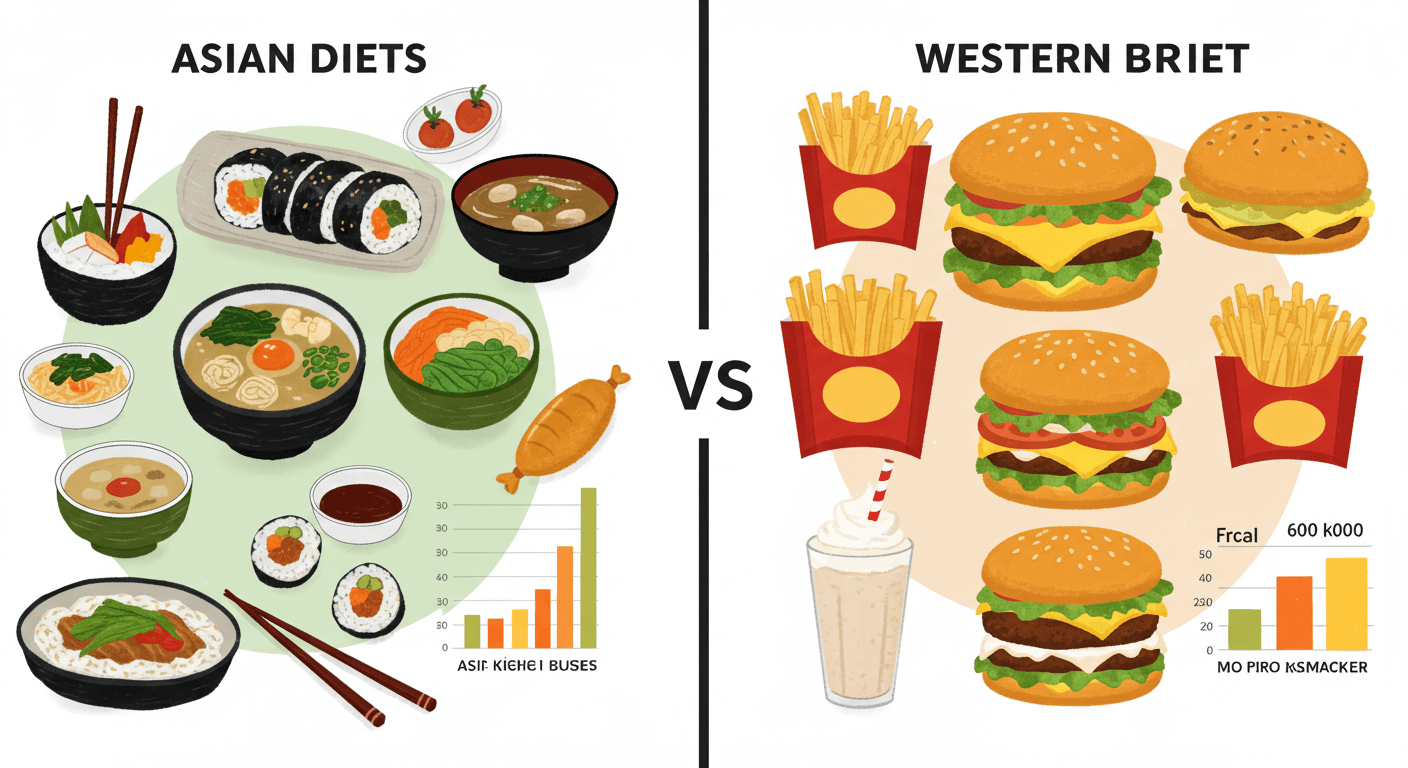Asian vs. Western Diet: Calorie Comparison
Published: March 3, 2025

Key Differences Between Asian and Western Diets
The Asian and Western dietary patterns differ significantly in composition, preparation methods, and caloric density. Understanding these differences can help explain variations in obesity rates, metabolic health, and overall calorie consumption between populations.
Staple Foods
- Asian diet: Rice, noodles, tofu, vegetables, fish, fermented foods
- Western diet: Bread, pasta, potatoes, dairy products, red meat, processed foods
Cooking Methods
- Asian diet: Steaming, stir-frying, boiling, fermenting
- Western diet: Deep-frying, baking, roasting, grilling
Meal Structure
- Asian diet: Multiple small dishes shared communally, small portions
- Western diet: Individual large portions focused on protein and carbohydrates
Caloric Content Comparison
Staple Carbohydrates
- White rice (1 cup, cooked): 200 calories
- White bread (2 slices): 160-200 calories
- Noodles (1 cup, cooked): 220 calories
- Pasta (1 cup, cooked): 220 calories
While the base caloric content is similar, Asian meals typically include smaller portions of these staples, accompanied by larger quantities of vegetables.
Protein Sources
- Tofu (100g): 70-100 calories
- Fish (100g): 100-150 calories
- Chicken breast (100g): 165 calories
- Beef (100g): 250 calories
Asian diets typically emphasize plant proteins and fish, which are lower in calories compared to the red meat common in Western diets.
Fats and Oils
- Sesame oil (1 tablespoon): 120 calories
- Olive oil (1 tablespoon): 120 calories
- Butter (1 tablespoon): 100 calories
- Coconut milk (100ml): 230 calories
While oils have similar caloric content, Asian cooking typically uses smaller amounts for flavoring rather than as a primary ingredient.
Average Daily Calorie Intake
Research suggests significant differences in average calorie consumption between regions:
- Japan: 2,719 calories per day
- China: 3,100 calories per day
- United States: 3,800 calories per day
- United Kingdom: 3,440 calories per day
These differences can be attributed to portion sizes, food choices, and cooking methods.
Health Implications
Obesity Rates
- East Asian countries: Generally under 5% (Japan, Korea)
- Western countries: Often exceeding 30% (United States, United Kingdom)
The lower caloric density of traditional Asian diets contributes to lower obesity rates in these populations.
Nutrient Density
Asian diets often provide more nutrients per calorie due to:
- Higher vegetable consumption
- Greater food diversity per meal
- Less processed food
Modernization and Changing Dietary Patterns
Traditional dietary patterns in both regions are changing with globalization:
Westernization of Asian diets
Increased consumption of meat, dairy, and processed foods leading to higher calorie intake
Asian influences on Western diets
Growing popularity of Asian cooking techniques and ingredients potentially lowering caloric density
Practical Applications for Calorie Management
Asian Cooking Techniques for Lower-Calorie Meals
- Use a wok for quick stir-frying with minimal oil
- Incorporate more vegetables into every meal
- Serve smaller portions of multiple dishes
- Use broths and light sauces instead of cream-based options
- Focus on fish and plant proteins over red meat
Conclusion
While both Asian and Western diets have their unique attributes, traditional Asian dietary patterns typically result in lower caloric intake due to smaller portions, less processed food, cooking methods that use less oil, and greater emphasis on vegetables and seafood. By adopting some principles from Asian cuisines, individuals following Western diets can potentially reduce their caloric intake while maintaining satisfying and nutritious meals.
Use our Recipe Calorie Calculator to analyze the caloric content of both Asian and Western dishes and make informed dietary choices based on your nutritional goals.